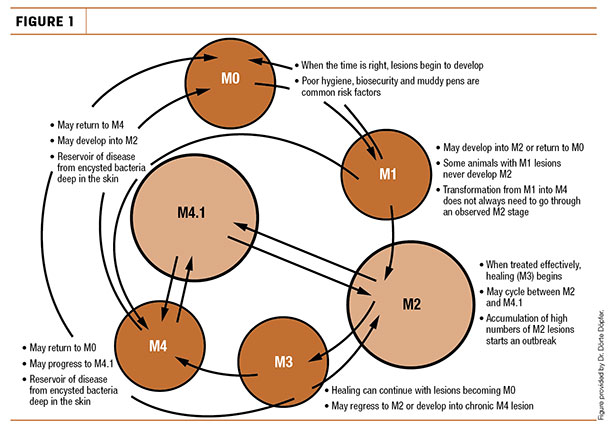How to control digital dermatitis (DD) is probably the most frequently asked question a hoof trimmer gets. The quick answer is: DD will always have to be dealt with, and your trimmer and trim day can do little to nothing to control it. So how do we break the cycle of digital dermatitis?
The best way to combat DD and keep it in a manageable state is to start looking at it the same way you look at mastitis. First, we need to know the different stages of the disease to see if our treatment and prevention protocols are actually preventing or just enabling the disease to be more aggressive.
Figure 1 and the chart (Break the DD Cycle) explain and show the different stages and the life cycle of DD developed by Dr. Dörte Döpfer and the University of Wisconsin.
Click here or on the image above to view it at full size in a new window.
Perhaps one reason DD has become such an epidemic in the industry is because for a long time, we only concentrated on the red “strawberry-like” lesion or “hair-like” wart. We figured whatever product we could use to “kill” the wart, the better.
However, we are beginning to learn that treating and footbathing cows may be causing some of our outbreaks and chronic cows. Once we see a large M2 lesion at the trim chute, we have lost the battle with that cow.
If you are seeing proliferated lesions (Figure 4), your program is failing either by inconsistent footbaths, baths that are too harsh or a combination of both.
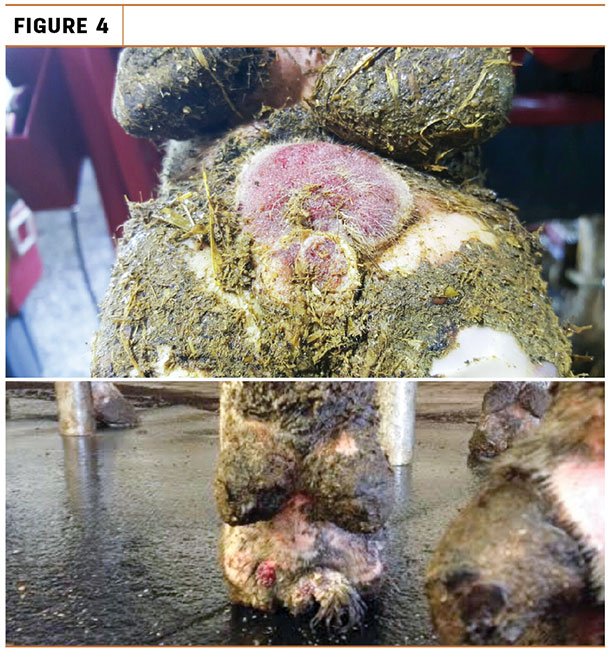
A sign your DD treatment and prevention program is working is when you see horseshoe-like scabs falling off the lesion area on the foot (Figure 2).
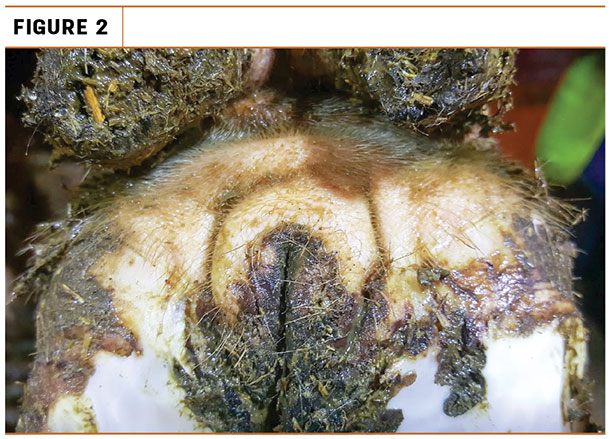
So how do we get less of the proliferated lesions and more of the lesions like Figure 2 and then a declining number of M4 chronic cows? For my clients, the following action steps are proving to be successful.
1. Early detection and treatment
We need to stop using footbaths as a treatment for DD and use them in the prevention of new M2 lesions. We don’t teat dip more during a mastitis outbreak, so we can’t expect running footbaths more often or at a higher concentration will treat ulcerated lesions.
On the contrary, this method may be the number one reason why DD has become so hard to keep under control.
Studies are beginning to show that dipping an ulcerated lesion in a 5 to 10 percent copper sulfate or formalin bath may be driving treponemes further down in the epidermis, creating a cow with chronic DD. Just like we monitor cows for mastitis, we need to look for ulcerated DD lesions and treat immediately.
This is easily done by parlor or pen walks and can be easily recorded in the DD Check app available on the app store or Zinpro website (Figure 3).
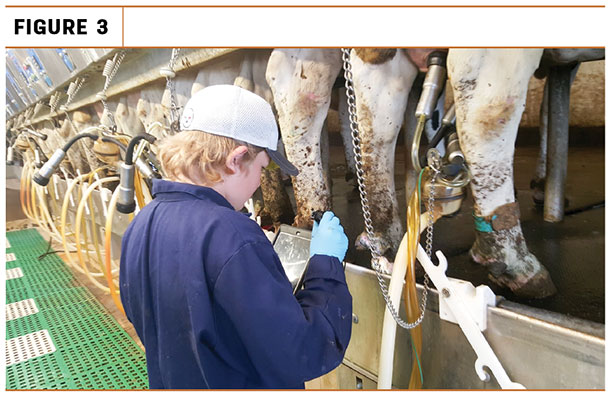
By using the DD Check app, you can actually create a graph showing and predicting where your herd is and which direction it is heading on DD control.
Just like mastitis, there are many treatment alternatives out there, but the best and proven treatment is early antibiotic treatment. The same is true for DD, with the recommended 2 grams or less of tetracycline per treatment and no greater than 20 percent of the herd treated at one time under the advisement and prescription from the herd vet.
The new Veterinary Feed Directive has made this protocol more complicated in the U.S., but that doesn’t mean it should be thrown out completely. The key is to not just treat, but also prevent.
Would you ever accept treating 20 to 80 percent of the herd for mastitis? Why do we accept DD levels this high? Just because you can still sell the milk? I’m not sure our consumers would accept that answer.
2. Proper footbath and hygiene
Just like mastitis is a disease influenced by hygiene, so is DD. Increasing alley cleaning at strategic times when cows are either away being milked or lying in their stalls helps improve foot and leg hygiene and lowers the environment for treponemes that thrive to produce new lesions and outbreaks.
Cross alleys are probably the number one neglected area. Cleaner feet also improve the effectiveness of foot dipping and allow more cows to go through the footbath before refreshing with more product.
Running footbaths is expensive and time-consuming, so it’s important to maximize the numbers of cows that can go through a bath with as little product needed as possible. Much of the efficiencies can be found in the footbath design. If your footbath volume is much more than 40 gallons, it probably is not designed for optimal results. It’s also important to ensure there is no way for the cow to side-step the bath.
This also ensures that most of the product stays in the bath where it belongs instead of being splashed out on the concrete. The footbath needs to be 10 to 12 feet long with a 10- to 12-inch curb to step over into the bath. Anything less than that is like dipping two or three teats consistently and blaming the product when mastitis flares up (Figure 5).
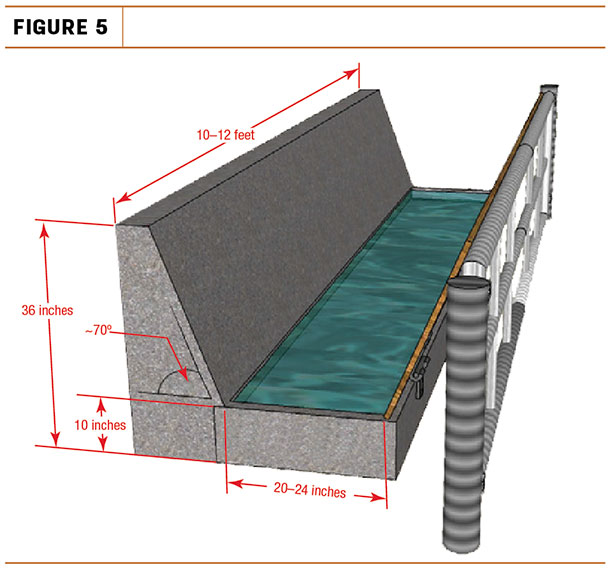 Another ineffective protocol is pre-baths to “wash” feet. A pre-bath will only make treatment less effective. If you doubt this is true, think again in terms of mastitis control. Would you dip a teat in water, then immediately follow with a regular teat dip? No. Remember, we are foot dipping, not washing; environment management is what ensures clean feet.
Another ineffective protocol is pre-baths to “wash” feet. A pre-bath will only make treatment less effective. If you doubt this is true, think again in terms of mastitis control. Would you dip a teat in water, then immediately follow with a regular teat dip? No. Remember, we are foot dipping, not washing; environment management is what ensures clean feet.
Also, don’t look to foot sprayers to replace footbaths in your robots. The new DD lesions (M1) start in the interdigital space where these sprayers don’t get product.
3. Footbath protocol: Less product, more frequent
When a herd experiences an outbreak, the “go-to” solution is often to use a higher concentration in the footbath. This may seem successful in the short term, but it is just enabling the disease in the long term. For me, copper sulfate is still the gold standard for a footbath product.
New products are introduced constantly, but with no regulation or mandatory trials needed, some end up doing little to nothing in DD control.
You can’t just look at what a product does over a few weeks; it really takes a few months to know if it’s effective. Even with copper sulfate, historically it’s always been recommended to use 5 to 10 percent concentration. It’s been thought that we needed the pH to be extremely low to be successful (pH1).
However, new research is showing this may not be the case, and optimal pH may be starting the bath at closer to pH3 and refreshing around pH5.
More work needs to be done in this area, but my clients who have changed from a 5 percent copper sulfate solution with a commercial acidifier to less than 2.5 percent and less of the acidifier have seen a reduction in proliferated lesions, more “horseshoe-like” M4 lesions, fewer outbreaks and fewer cases of new M2 lesions – and while still achieving the same cow numbers through the footbath.
These herds also increased frequency of baths from two to three times per week to four to six times per week, but they use the same or less total product on a weekly basis. The move toward daily foot-dipping has also made it a “routine” for the employees, just like teat dipping, so less likely to get missed.
4. Don’t forget the dry cows and heifers
The biggest setback in breaking the DD cycle is the dry cows, especially when the prefresh heifers are neglected. Just like mastitis, the bacteria involved in DD are always present and looking for an opportunity to do their thing and explode into an outbreak. To achieve a low-SCC herd with few mastitis cases, dry cow management is key.
If we do a great job in the lactating herd keeping chronic M4 cows in check but then send them to a dry pen and stop prevention methods, they can’t help but start the cycle all over again.
These problems usually erupt right around freshening, increasing the risk of foot rot and other complications because of lameness at this high-stress time. Then they enter the lactating herd, and the cycle of outbreaks begins all over again.
If a herd can keep heifers from experiencing ulcerated lesions before first lactation, the risk of having a lesion later on is dramatically reduced. To decide where heifer prevention should start, perform a foot inspection and find the youngest group of infected animals and start a prevention program in the group younger than that.
A study at Iowa Sate University with Drs. Jan Shearer and Paul Plummer shows it takes about 133 days for new lesions to get to the visible M2 ulcerated stage. The problem doesn’t start in the group with lesions; it starts in the group before that.
Another study by Dr. Arturo Gomez shows an increase in first-lactation milk production will more than pay for a preventative footbath program and proven mineral supplement in prefresh heifers.
If we start looking at DD through the same lens as we do mastitis, the disease can be very manageable. Every producer knows which are their high-SCC cows and trains their employees to look for mastitis at milking time. In the same way, we also need to know who our chronic M4 cows are, similar to knowing the high-SCC cows.
We don’t have a milk test like we do for SCC, yet I can’t emphasize enough the benefits of scoring the lesions on the DD Check app and providing this list to employees on your farm. These will be the first cows to show signs of an outbreak. They will also be the first cows to give you a good evaluation of how your footbath prevention program is working.
Unfortunately, I can’t give you an exact step-by-step program in an article, as every farm will need to tweak these action steps and monitor and adjust for results in their herd. The basis is the same, but key focus areas will vary.
One tip I will leave is: Once ulcerated lesions are under control, don’t cut down how often you run a footbath each week – rather, cut down on the concentration of the footbath. Eventually, on a successful program, copper sulfate may be able to be substituted for a cheaper alternative like feed-grade salt once or twice a week, but I recommend keeping frequency constant.
Don’t just evaluate protocols based on the effect on M2 lesions; look at what is happening with the M4 lesions and chronic cows.

